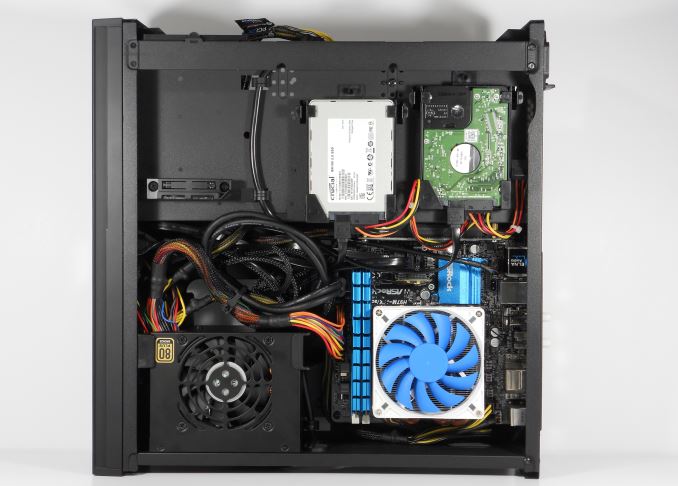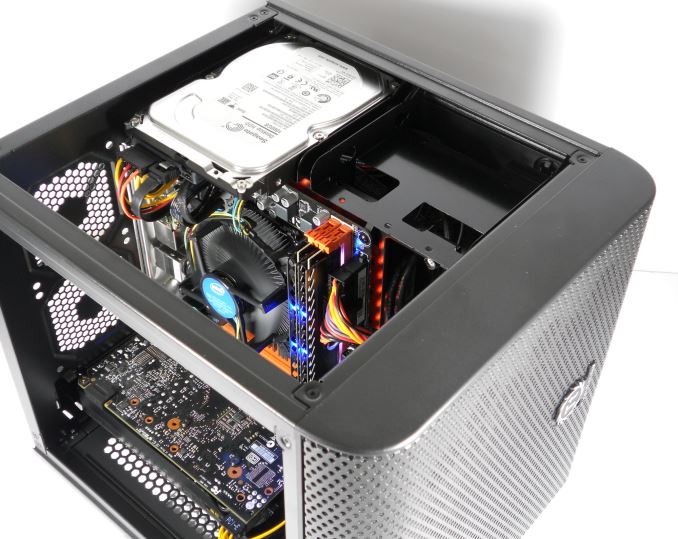Build-A-Rig Round 2, SilverStone vs. Crucial: The $800 PC Showdown
by Daniel Williams on November 12, 2015 8:00 AM EST- Posted in
- Build-A-Rig
- Systems
- Crucial
- SilverStone

We’re back again for the final phase of our second Build-a-Rig competition. For this round we are doing a theme relevant to many a younger enthusiast: back to school computers. In this Round we invited both Tony Ou from SilverStone and Jeremy Mortensen from Crucial to each spec out an $800 computer for the back to school season.
Earlier we interviewed both representatives to discuss their own background and also to find the motives behind the configurations they submitted. Last week we got to dive into the experience of building these computers, and got to see what it is like to put these machines together and how easy they are to work on for those that like to get their hands dirty.
Now for the final part of this round of Build-a-Rig we have the showdown: running our benchmark suite and seeing how these machines compare to each other. The $800 budget this time is substantially tighter than what we saw in our previous round, which when coupled with both machines being built on mITX platforms for portability brings its own constraints, and as a result we can see completely different trade-offs being made on both sides.
With such differing priorities there can't be one clear winner purely on performance alone. For students this is just as complicated as any other use case since what kind of computer is best will depend entirely on the class load being taken. If either a student just needs a machine to type out homework on and game or has software that leans heavily on the GPU, then SilverStone’s Mighty Milo may make a strong showing. But there are still disciplines out there that either don't use GPU acceleration extensively or where a stronger CPU is needed to back it up. Maybe Crucial's Ballistix Bantam is prepared and ready with its more capable Core i3-4170. Even then, some students either don't game much or focus on games that don't need a crazy computer and would prefer a multitasking monster to run everything at once.
Last but certainly not least of course is the giveaway. At the end of the Build-A-Rig challenge we will be giving these systems away, and that means today is the last day to enter. Two lucky winners within the United States will be receiving these completed systems for their computing pleasure. So if you have yet to enter, you will want to do so before midnight tomorrow, November 13th.
Build-A-Rig Round 2 Entry Form
The Builds So Far
Last week we took a look at the assembled SilverStone and Crucial designs. So before jumping into our benchmarks, let’s quickly recap the systems and their parts.
SilverStone's Mighty Milo
SilverStone’s Mighty Milo aims to be a low profile machine with its narrow case and is potentially a quieter machine with only the fans necessary to keep hot components cooled off. Inside we find a Zotac GeForce GTX 960 and a more affordable Intel Pentium G3258 driving the system. Sitting on top of the overclockable Pentium is a Silverstone ARO6 cooler that will either maintain quiet CPU cooling or provide enough cooling to crank up the clock speed depending on the end user’s preference. The motherboard supports Wireless AC and a 120GB Crucial boot SSD will house Windows and any important software.
| SilverStone's Mighty Milo | |||
| Component | Selection | Price as Chosen |
90-Day Average |
| Processor (CPU) | Intel Pentium G3258 (2C/2T, 3.2 GHz) |
$69.99 | $69.99 |
| Motherboard | ASRock H97M-ITX/ac | $95.99 | $93.20 |
| Graphics Cards (GPU) | Zotac GeForce GTX 960 OC | $179.99 | $179.99 |
| Memory (DRAM) | Crucial Ballistix Sport XT (2x4GB) DDR3-1600 C9 |
$39.99 | $43.95 |
| Storage (SSD) | Crucial BX100 120GB | $69.99 | $67.75 |
| Storage (HDD) | 1TB Western Digital Blue 2.5-in 5400 RPM 8MB Cache |
$60.99 | $60.99 |
| Power Supply (PSU) | SilverStone ST45SF 450W Bronze SFF |
$69.99 | $71.33 |
| Chassis | SilverStone Milo ML08B-H (with handle) |
$84.99 | $84.99 |
| CPU Cooling | SilverStone Argon AR06 | $39.99 | $39.99 |
| Operating System | Microsoft Windows 10 Home 64-bit OEM |
$99.99 | $99.99 |
| Extras | None | ||
| Total | $811.90 | $812.17 | |
There is one more quick note to be made on the Mighty Milo. As mentioned earlier this machine houses a Pentium G3258. At stock it is a humble dual-core processor, but it has also made quite the splash by being one of the first overclockable budget CPU's to come out of Intel in some time. The ASRock H97M-ITX/ac board that in turn holds the CPU has built-in overclocking profiles for easy performance tuning. In our interview with Tony, he said that he expected the chip to do around 4GHz. To my pleasant surprise not only did the SilverStone AR06 do a good job of keeping up with the chip at 4GHz, but I was also able to hit 4.2GHz at 1.28v via the H97M-ITX/ac’s built-in overclocking profile, and with a little fiddling still I settled on a stable 4.3GHz at 1.3v. This overclock is stable for the entirety of our test suite, but whether or not this machine lives overclocked or stock will be up to its soon to be owner.
Crucial's Ballistic Bantam
Moving on to Crucial's Ballistix Bantam we have a cube shaped Thermaltake case housing an Intel Core i3-4170 and an EVGA GeForce GTX 950. Though this computer doesn't house an overclockable chip with a large cooler it packs better stock performance thanks to AVX and Hyperthreading, along with a larger SSD for housing important data. In addition as we saw in the build logs I found this case easier to build in and tidy up and I would suspect that this machine will continue to be the easier machine to upgrade and customize in the future.
| Crucial's Ballistix Bantam | |||
| Component | Selection | Price as Chosen |
90-Day Average |
| Processor (CPU) | Intel Core i3-4170 (2C/4T, 3.7 GHz) | $124.99 | $124.82 |
| Motherboard | GIGABYTE GA-B85N Phoenix-WiFi | $84.99 | $84.99 |
| Graphics Cards (GPU) | EVGA GeForce GTX 950 | $159.99 | $159.99 |
| Memory (DRAM) | Crucial Ballistix Tactical Tracer 2x4GB DDR3-1600 C8 |
$47.99 | $48.92 |
| Storage (SSD) | Crucial MX200 mSATA 250GB | $94.99 | $94.99 |
| Storage (HDD) | Seagate Barracuda 1TB 7200RPM | $50.99 | $49.81 |
| Power Supply (PSU) | Thermaltake TR2 600W | $54.99 | $55.05 |
| Chassis | Thermaltake Core V1 Extreme Cube | $49.99 | $49.99 |
| CPU Cooling | None | - | - |
| Operating System | Microsoft Windows 8.1 64-bit OEM | $99.99 | $99.99 |
| Extras | LG USB 2.0 Portable DVDRW | $24.99 | $24.99 |
| Total | $793.90 | $793.54 | |
With introductions out of the way let's take a look at how these computers perform.













43 Comments
View All Comments
DanNeely - Thursday, November 12, 2015 - link
At the same time, the efficiency penalty from being significantly below the PSUs sweet spot is much larger than from being near its max output. You're also paying a lot in higher running costs now for that big low efficiency PSU. At typical US energy prices, if you leave it on 24/7 it's about $30/year; and is still $10/year if only on for 8 hours a day (triple these numbers for somewhere like Hawaii or Germany that have really high power costs). A 450/500W model makes a lot more sense now and would do much better in the face of your potential high end upgrade than the current one does now. If you're going with an oversized PSU now because you don't want to buy a bigger one after a future planned upgrade, it really pays to get a high efficiency model to avoid the much higher operational costs when the system is at idle.BrokenCrayons - Thursday, November 12, 2015 - link
The cost concern would vary from place to place, as you've pointed out, but I think the difference in cost even in areas where electrical rates are high aren't that significant. Say you'd spend $90 a year feeding a computer electricity to leave it on 24/7 in a high cost area of the world. A more efficient power supply that burns less power might help, but you'd realize a pretty small overall price difference over the useful lifespan of the computer. I don't deny the idea of a more efficient, lower wattage PSU being a better choice, but I don't think electrical costs are a very significant factor in computing hardware unless the savings are pretty dramatic (say netbook vs gaming desktop) or involve large numbers of computers in a business/enterprise environment.However, I wouldn't even upgrade a system like the Crucial box unless I could do so by waiting a few GPU generations to get more performance for less wattage rather than grabbing a higher end and more demanding current generation part, but I'm also pretty happy with gaming on a GeForce GT 730. If my desktop vanished today, I'm also not against using my admittedly old Atom n270 netbook as my only computer since gaming isn't a major concern. As such, I'm guessing you're more well informed and better suited to make a recommendation. :)
DanNeely - Friday, November 13, 2015 - link
You appear to be misunderstanding my numbers. It's not $90 total, it's $90 *more*. The rule of thumb conversion factor for something on 24/7 is that at a price of 10 cents/KWH is equal to 1 dollar/watt-year. Somewhere that power is 10c/kwh (slightly below the US average) the Might Milo would cost $38/year left at idle, Ballistic Bantam would cost $64; a $26/year difference. At 35c/kwh its $133 vs $224 per year for power, that 26 watt difference ends up costing an extra $91/year.BrokenCrayons - Tuesday, November 17, 2015 - link
Oh, okay! Sorry for the misunderstanding. I do think the cost difference isn't that significant in the grand scheme of things. In the hypothetical college student in a dorm situation, electrical inefficiency isn't going to result in a cost increase unless the university is metering individual dorms. They didn't when I was a student, but that isn't even remotely recent history. For someone who's paying their own electrical bills, $90 a year is only the price of one person's dinner at a nice restaurant. I still agree the power supply is overkill, but energy costs just aren't dramatic enough to matter. Don't buy that extra pair of shoes or skip out on girls/boys night out once or twice -- you won't miss them anyway since you'll be busy playing whatever game it is that makes you happy anyway.nikaldro - Thursday, November 12, 2015 - link
I think you should have tested frame times. 2 vs 4 threads can make a substantial difference sometimes.tipoo - Thursday, November 12, 2015 - link
Yeah, Digital Foundry has pretty much solidified that even two extra virtual threads make a huge difference. 2 cores alone can sometimes drop a lot of frames in a game, two cores with hyperthreading for four virtual threads usually does really well. To the point where the CPU can push over 60fps in games if the GPU is up to it.geniekid - Thursday, November 12, 2015 - link
It's interesting to see how balanced both systems are - they both run into various bottlenecks depending on the application/settings. Objectively, I feel Crucial's more balanced system is the better choice for a true back-to-school system but, subjectively, overclocking SilverStone's G3258 by 34% is much cooler. I'd recommend the former to someone else. I'd take the latter for myself :)Flipper34 - Thursday, November 12, 2015 - link
Not too bad for the price.crimson117 - Thursday, November 12, 2015 - link
Giveaway, shmiveaway! I hope I win.reorx - Thursday, November 12, 2015 - link
This is the perfect PC build for school - especially that Silverstone slim case!